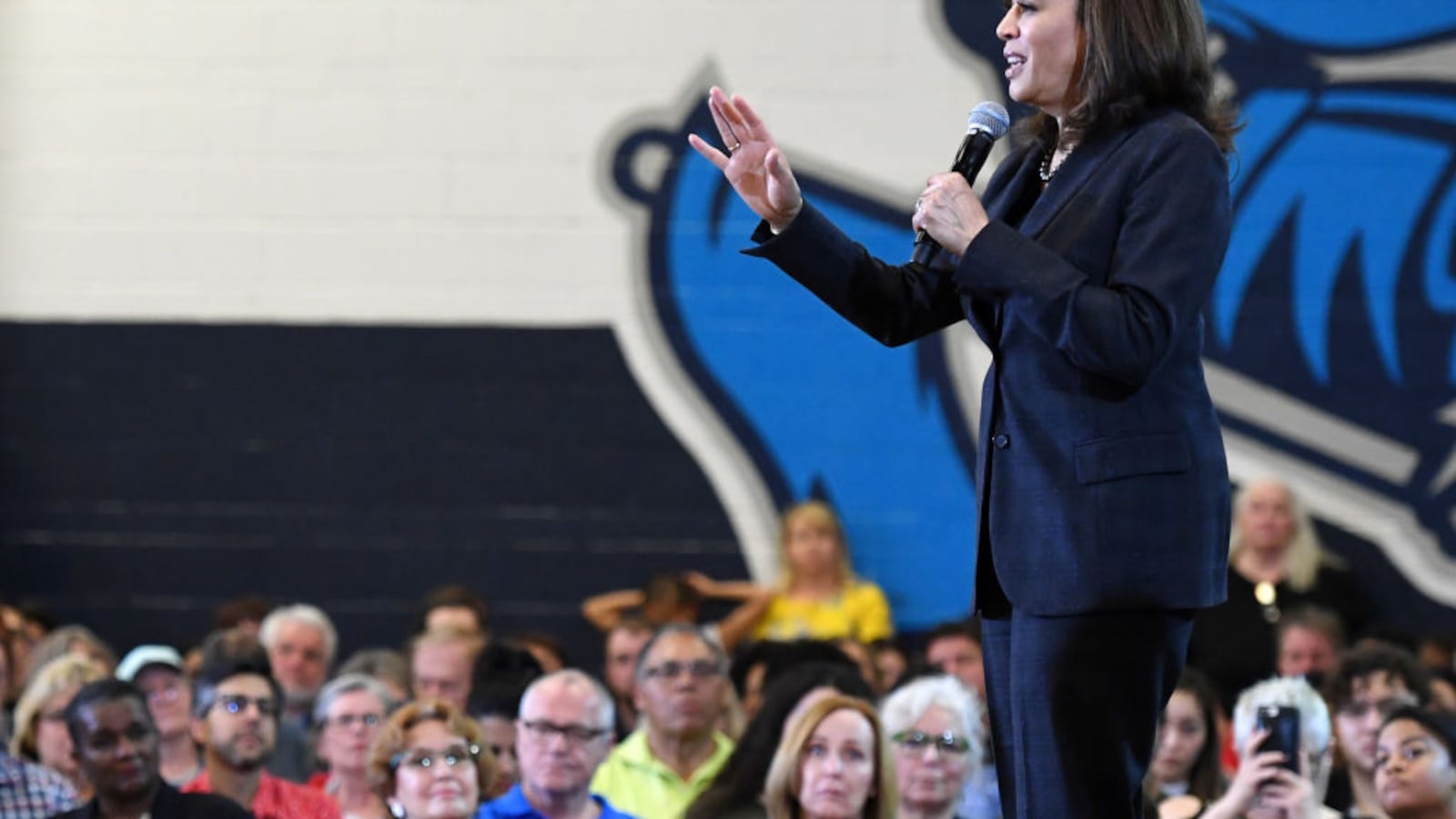Democratic presidential candidate Kamala Harris introduced an ambitious — and expensive — plan to raise teacher pay across the U.S. in a bid to win the support of insurgent teachers and an increasingly sympathetic public.
The California senator’s proposal, outlined by her campaign Tuesday, aims to close the compensation gap between teachers and similarly educated professionals. Nationally, they make 11 percent more in pay and benefits than teachers do, according to a recent analysis.
To change that, Harris aspires to give the average teacher a $13,500 pay raise, with the exact number based on the size of each state’s pay gap. The campaign estimates it would cost the federal government $315 billion over 10 years. For comparison, U.S. public schools took in $678 billion in fiscal year 2016, including $56 billion from the federal government.
The price tag may make the initiative a tough sell in some quarters. But the size of the investment also makes the plan more likely to achieve the central goal of attracting and retaining teachers.
“It isn’t enough to just say our teachers shape the future of our country, we should pay them like it,” Harris tweeted Sunday. “It’s past time we value and respect their work, compassion, and dedication to our kids.”
The plan is the first substantive proposal from a presidential candidate that responds directly to a national wave of teacher activism that began with West Virginia’s teachers strike in 2018. Teachers in Oklahoma, Arizona, Los Angeles, Oakland, and Denver have followed.
Teachers’ demands have varied, but disagreements over salaries have played a major role in most of the strikes and walkouts. And educators seem to have been successful in winning more funding for public schools in several states, including Oklahoma and Arizona, without losing public support.
Harris’s campaign says it would work with states to set salary goals, and incentivize them to spend more with a three-to-one match for every dollar states put toward raising teacher pay “until the teacher pay gap is entirely closed by the end of Harris’ first term.” That implies that the federal government would make different investments in different states, as some have much larger teacher pay gaps than others.
The plan calls for an “additional targeted investment” in high-poverty schools to boost pay even further, but offers no details on how it would do so.
Similarly, it is light on details for the how the initiative would be paid for, saying the money will come from “strengthening the estate tax and cracking down on loopholes” used by wealthy taxpayers.
By omitting any mention of performance pay, the plan also differentiates Harris from a previous generation of Democratic leadership on the issue. President Obama backed performance pay systems as a candidate and while in office. (A number of Democratic candidates, including Harris, have regularly expressed support for striking teachers.)
Harris’s plan is likely to be popular with the nation’s teachers unions, too — organizations with money and manpower to offer a presidential campaign. It has already won plaudits from the leaders of the two largest unions, Lily Eskelsen García of the National Education Association and Randi Weingarten of the American Federation of Teachers.
“For every teacher in America and for the 91 percent of kids who attend our public schools, this is one of the most thoughtful initiatives we’ve seen in years,” Weingarten said in a statement timed with the plan’s Tuesday morning release.
Studies have found that pay increases generally improve the likelihood that teachers will stay in the classroom, and lower turnover has been linked to improved student test scores. Recent international research has found that teacher pay is positively correlated with teachers’ academic skills — and in turn, connected to higher rates of student learning. Research has also connected school spending increases, some of which likely went to teacher pay, to academic gains for students.
“I think there’s really good evidence that teachers respond to salaries,” said Dan Goldhaber, a professor at the University of Washington who studies teacher quality but has not reviewed Harris’s plan. “And there is some evidence that ultimately, that affects students.”
But, Goldhaber argued, efforts to boost teacher salaries should focus on the positions where higher salaries could make the most difference — for new teachers more likely to leave the profession, for example, or for teachers in low-income schools where turnover is high.
“We would probably be better off if whatever pot of money is being allocated to raising teacher salaries tended to disproportionately go to schools serving disadvantaged kids, the front end of pay in a teacher’s career, and to shortage subjects,” he said.
There are longstanding debates about exactly how to measure how teachers are paid, especially around how to account for factors like pensions, working conditions, and job security. Some argue that if you take all that into account there is no teacher pay gap. Critics also claim that teacher raises could be accomplished without spending more, but instead cutting the number of non-teaching staff in schools, like administrators and cafeteria workers.
One recent study compared giving teachers 1 percent across-the-board bonuses to using a similar amount of money to give larger raises to teachers with better performance ratings. Measures of teacher retention and student test scores were slightly higher in the second group.
Allison Atteberry, a professor at the University of Colorado Boulder, said she thinks it makes sense to substantially raise teacher pay, but questioned the feasibility of widespread increases.
“Dramatically increasing base pay for all teachers would be my first policy choice, because it could elevate the entire profession in the eyes of society for generations to come,” she said. “But in a more realistic world where there are hard constraints on how much more the public is willing to spend on education, I would suggest increasing the salaries most for teachers who are most capable of changing the life trajectories of their students.”


